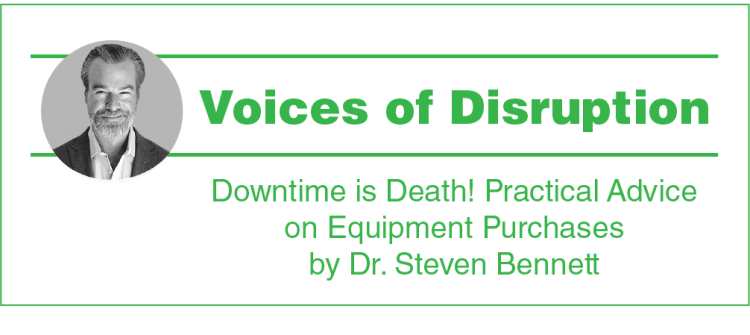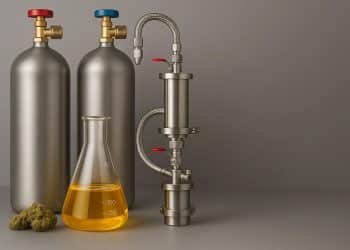Opinions are not hard to come by and they can often be marketed as facts. For someone greener to the cannabis industry, the advice, solicited or not, can whizz by like blow darts, some potentially poison tipped. “No one does that extraction technique anymore!” “Those other companies are too expensive.” “If you don’t do it this way, you’re not doing it right.”
These statements sound reasonable enough, but the proof is in the pudding. It’s vital for an industry newcomer to be able to trust in those whose advice they seek and not restrict the growth of their own success by believing in tales drafted by others.
Sensibly authoring your extraction adventure on page one of your story, using real data, unbiased feedback, and ties made with responsible vendors can prevent you or those toxic darts from writing your epitaph.
“Downtime is death,” said Steven Bennett, Ph.D., founder, and chief scientific officer of Prescott Logic Technologies. Downtime means death to your processes, which in turn, eradicates profits and jobs, and ultimately digs the company’s crypt. I asked Dr. Bennett for some examples of common mistakes that someone new to the cannabis industry might make when purchasing equipment that might lead them to this untimely demise.
“Some will try to buy hype,” he answered. “While some companies may have been around for a while, they may have done nothing to change their design. They may boast a performance that’s just not possible. Luckily, these companies are getting sussed out.”
Another mistake you can make regards trying to save money. Of course you want to save money where you can, but what if spending a little more upfront meant less headaches and other injuries from faulty, frail equipment? There’s no Magic 8 Ball or Ouija board here, so your upfront, data-driven decisions pave your path to the future.
“You want to be smart about where you try to save money without pigeonholing your capabilities,” Bennett advised. “Take short-path distillation, for example. You may spend just $20K for the gear, but you may use a ton of labor, the equipment may (and likely will) inconsistently perform, there will be a lot of breakage, and you cannot upgrade.”
A dollar saved may not be a dollar earned.
So, what should a business looking to purchase equipment for their extraction facility be mindful of when evaluating options?
“First and foremost,” Bennett advised, “are the regulations, especially fire regulations and whether a facility will need C1D1 or C1D2 certification. This is a capital expenditure that might not be realized upfront.
“A second thing to be cognizant of is the level of support that you can expect from the groups that you’re interested in buying equipment from. All equipment has a learning curve, and everything breaks, so coming to terms with the level of involvement that you expect from your choice vendor is vital.
“And then, there’s the overall operating expenses for a given piece of equipment such as power consumption, heating, ventilation and air conditioning management, specific solvents, and other consumables that are required for operation, especially 24/7 operations.”
You, as the extractor, must have an idea (or better yet, a detailed spreadsheet) regarding what these costs add up to because they provide the total cost of ownership which can paint a very different scene from the equipment’s sticker price. This means that when someone says equipment is too expensive, it’s rarely that cut and dry. Perhaps the sticker price, yes, but what about the needed ancillary goods and people? The truth is often more intricate.
Given that we live in misinformed times where false news travels faster than the truth, I was curious what Dr. Bennett’s thoughts were on the misconceptions regarding purchasing cannabis processing equipment.
“Good one,” he remarked. “The first misconception is that cannabis extraction is easy! Whoever sells equipment on the premise that it’s smooth and easy is flawed to begin with. Cannabis is a sticky mess.
“Another major misconception is that it’s consistent — in reality, the same material can be ground, extracted, and distilled differently. The idea that you could press a button, insert cannabis, and get the same output is a misconception.
“It’s really a matter of garbage in, garbage out. The better the quality of material, the smoother the experience will be. It’s a mess that needs to be cleaned up. There’s no reason to think that there’s a corner to cut.”
So, you’re following this article, new to cannabis extraction. You’ve read that you may need to spend more to save more. You can’t cut corners. And that the most expensive equipment to produce your products may not actually be the most in the long run. How can a smaller business on a shoestring budget proceed with purchasing the best equipment for their dollar?
“There’s no right answer or one size fits all,” Dr. Bennett admitted. “It’s whatever fits the business case. Being smart and not necessarily cheap is very important. Being able to upgrade equipment or add modules is critical.
“It’s important that you plan to succeed. Upgradability is something that we really harp on, and we work with groups that do the same because certain throughputs might be needed now, but you’re going to be successful and need more, so plan for that! You have all the options available to you in the beginning. Really be focused on support for parts and optimization of conditions.
“Time is money, and I can’t stress that enough, because when you have distribution for distillate, and you’re told that a part can’t be obtained for 4 to 6 weeks, you are dead in the water. You need to choose companies that have parts on hand.”
Even better than only stockpiling replacements for parts that commonly fail, designing equipment for long-term success from the start can mean higher upfront costs, but lower costs over time. From a distillation-gone-wrong perspective, terpenes and residual ethanol can wreak havoc on rotary vane vacuum pumps, ultimately requiring them to be replaced. Prescott circumnavigated this by using a more suitable dry scroll vacuum pump.
“We are one of the only groups that use a dry scroll vacuum pump versus a rotary vane pump,” Bennett added. “Rotary vane pumps have a few liters of lubricating oil that all of your extract is pulled through. Terpenes mix with that oil, and the oil gunks up O-rings, pumps, and eventually you are rebuilding or replacing the pumps. Rotary vane vacuum pumps are not meant to handle solvents or terps; with a dry scroll pump, you open a ballast to vent volatiles, and the pump is literally designed to handle the excess solvent.
“Another aspect of buying inexpensive equipment regards the gear pumps, which take material in and out of vacuum such that you can run continuously. They are a critical component. You’ll be running into trouble instead of just running!”
A massive question when purchasing equipment regards how the current cannabis landscape will change with increased legalization where amazingly, interstate commerce might be finally permitted. I asked Dr. Bennett for his insights into whether scalability will become a major issue for processors used to just making enough product for the needs of their own state.
“The craft versus mass production question will lay itself out,” he answered. “Craft favors smaller equipment like you’re seeing in the state-to-state markets. Mass production obviously favors larger equipment. Multi-state operators are looking to repeat a theme; instead of having a centralized processing center, there’s built-in redundancy so that one state can cover another state. People like to stick with what works and they will favor redundancy so that they’re always operational instead of having one large extractor that, if it goes down, they are totally screwed. The current multistate operators will probably still prefer multiple production sites with a local feel to them to embody the craft buzz.”
On a more personal level, the path from scientist to business entrepreneur isn’t easy. It can take a lot of manual labor to hack out the path to walk on. Bennett (and many other scientists in the cannabis industry) came from structured laboratory settings to an industry that had been outlawed for decades. I asked him what having the opportunity to create a business within the cannabis space meant for him scientifically and personally.
“What’s really been amazing is that, even though I have a PhD, PhDs are not really taught to do much else,” he reflected. “Therefore, we generally seek out other research positions, we write grants to ask for money, we need resources to get things done. This was the first time in my life that I created something from nothing. I bootstrapped a company, forged very strong relationships with manufacturing partners in Germany, and really, for the first time, was not dependent on the resources of a large institution to do the work.
“That really ties into what I’ve gained on a personal level, a true sense of personal freedom balanced by a higher level of responsibility than I ever dreamed of. A lot of people get tired of watching other people mismanage their businesses. The personal freedom associated with running your own business, for me, has been unparalleled.”












